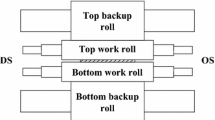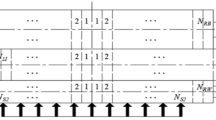Abstract
Skin-pass rolling (or temper rolling) is the final operational step in the production chain of hot-rolled strips, and its main role is to apply a small deformation to the hot-rolled strips cooled to room temperature to improve the shape quality and mechanical properties. Because of the absence of rolling lubricants between the work roll and strip as well as the existence of obvious oxide layer on the strip surface, the wear of work roll is very serious, which exerts an adverse effect on the shape control precision of hot-rolled strips. In this study, the wear law of work roll is obtained by a theoretical analysis of roll wear mechanisms as well as an elastic-plastic finite element analysis of skin-pass rolling. Using the above-mentioned wear law, a work roll wear model is constructed with parameters optimized by the three-population particle swarm optimization and differential evolution algorithm. The newly established wear model is validated experimentally in the field. Calculated values coincide well with those obtained from experiment. The wear model can be used for guiding the actual production.
Similar content being viewed by others
References
Kijima H (2015) An experimental investigation on the influence of lubrication on roughness transfer in skin-pass rolling of steel strip. J Mater Process Technol 225:1–8. https://doi.org/10.1016/j.jmatprotec.2015.05.023
Sun JN, Huang HG, Du FS, Li XT (2009) Nonlinear finite element analysis of thin strip temper rolling process. J Iron Steel Res Int 16(4):27–32. https://doi.org/10.1016/S1006-706X(09)60056-X
Zheng XT, Zhang J, Li HB, Cheng FW, Hu WD, Shi L (2015) Work roll uneven wear prediction model in broad-strip hot rolling mill. Iron Steel 50(5):49–53. https://doi.org/10.13228/j.boyuan.issn.0449-749x.20140640
John S, Sikdar S, Mukhopadhyay A, Pandit A (2006) Roll wear prediction model for finishing stands of hot strip mill. Ironmak Steelmak 33(2):169–175. https://doi.org/10.1179/174328106X80091
Spuzic S, Strafford KN, Subramanian C, Savage G (1994) Wear of hot rolling mill rolls: an overview. Wear 176(2):261–271. https://doi.org/10.1016/0043-1648(94)90155-4
Colás R, Ramı́rez J, Sandoval I, Morables JC, Leduc LA (1999) Damage in hot rolling work rolls. Wear 230(1):56–60. https://doi.org/10.1016/S0043-1648(99)00081-2
Tahir M, Widell B (2003) Roll wear evaluation of HSS, HiCr and IC work rolls in hot strip mill. Steel Res Int 74(10):624–630. https://doi.org/10.1002/srin.200300242
Shang F, Li HB, Kong N, Zhang J, Hu C, Chen L (2016) CVC cyclical shifting mode and its working characteristics for the mills of CSP. Int J Adv Manuf Technol 87(5–8):1907–1916. https://doi.org/10.1007/s00170-016-8602-8
Li YL, Cao JG, Kong N, Wen D, Ma HH, Zhou YS (2017) The effects of lubrication on profile and flatness control during ASR hot strip rolling. Int J Adv Manuf Technol 91(5–8):2725–2732. https://doi.org/10.1007/s00170-016-9910-8
Li XY, Zhang J, Chen XL, Zhao XM, Jia SH, Huang T (2002) Wear of rolls in single-stand temper mill and its effect on the strip shape. J Univ Sci Technol Beijing 24(3):326–328. https://doi.org/10.3321/j.issn:1001-053X.2002.03.025
Liu HC, Zhang J, Cao JG, Xu HB, Wei GC, Wang AS, Li J (2008) Research of wear model for work roll on hot strip temper mill. Metall Euip 5:21–24. https://doi.org/10.3969/j.issn.1001-1269.2008.05.006
Yang GH, Zhang J, Zhou YZ, Wang AS, Zhu XY (2009) Work roll non-uniform wear and shape cnotrol performance of the 2250 hot temper mill in WISCO. J Univ Sci Technol Beijing 31(8):1051–1056. https://doi.org/10.3321/j.issn:1001-053X.2009.08.020
Xu HB, Zhang J, Cao JG, Liu HC, Zhou YZ, Wang AS, Zhu XY, Li J (2010) Optimization and application of roll contour configuration of long shifting stroke hot tempering mill. J Cent South Univ (Sci Technol) 41(4):1340–1347
Zhang J, Xu HB, Li HB, Liu HC, Zhou YZ (2011) Uneven wear of work roll and its reduction measurement on hot strip temper mill. J Cent South Univ (Sci Technol) 42(6):1611–1616
Wang XC, Yang Q, Zhao YT (2010) Research on hybrid PSODE with three populations based on multiple differential evolutionary models. International Conference on Electrical and Control Engineering, Wuhan, China, pp 1692–1696
Wang XC, Yang Q, Sun YZ (2014) Research on comprehensive optimization of tandem cold rolling setting control system. J Mech Eng 50(6):39–47. https://doi.org/10.3901/JME.2014.06.039
Chen CC (2015) Research on buckling behavior of hot rolled strip in finishing mills. Dissertation, University of Science and Technology Beijing
Cai LF, Zhang J, Cao JG, Wei GC, Chen G, Zhu XY (2007) Study on the wear of the working roll in temper rolling mill for hot strip. Metall Euip 2:38–41. https://doi.org/10.3969/j.issn.1001-1269.2007.02.010
Gan ZT, Yu G, He XL, Li SX (2017) Numerical simulation of thermal behavior and multicomponent mass transfer in direct laser deposition of Co-base alloy on steel. Int J Heat Mass Tran 104:28–38. https://doi.org/10.1016/j.ijheatmasstransfer.2016.08.049
Gan ZT, Liu H, Li SX, He XL, Yu G (2017) Modeling of thermal behavior and mass transport in multi-layer laser additive manufacturing of Ni-based alloy on cast iron. Int J Heat Mass Tran 111:709–722. https://doi.org/10.1016/j.ijheatmasstransfer.2017.04.055
Gan ZT, Yu G, He XL, Li SX (2017) Surface-active element transport and its effect on liquid metal flow in laser-assisted additive manufacturing. Int Commun Heat Mass 86:206–214. https://doi.org/10.1016/j.icheatmasstransfer.2017.06.007
Li B, Zhang QD, Zhang XF (2015) Heredity and evolution laws of flatness defects in steel strip temper rolling process. Chin J Eng 37(2):231–237. https://doi.org/10.13374/j.issn2095-9389.2015.02.015
Colak B, Kurgan N (2018) An experimental investigation into roughness transfer in skin-pass rolling of steel strips. Int J Adv Manuf Technol. https://doi.org/10.1007/s00170-018-1691-9
Zhang QD, Li B, Zhang XF (2014) Research on the behavior and effects of flatness control in strip temper rolling process. J Mech Eng 50(8):45–52. https://doi.org/10.3901/JME.2014.08.045
Wang XC, Yang Q, Jiang ZY, Xu JW (2014) Research on the improvement effect of high tension on flatness deviation in cold strip rolling. Steel Res Int 85(11):1560–1570. https://doi.org/10.1002/srin.201400048
Kijima H, Bay N (2006) Modelling of skinpass rolling by elasto-plastic analysis of plane strain upsetting. J Mater Process Technol 177(1–3):509–512. https://doi.org/10.1016/j.jmatprotec.2006.04.113
Kijima H, Bay N (2007) Contact conditions in skin-pass rolling. Cirp Ann-Manuf Techn 56(1):301–306. https://doi.org/10.1016/j.cirp.2007.05.070
Kijima H (2013) Influence of roll radius on contact condition and material deformationin skin-pass rolling of steel strip. J Mater Process Technol 213(10):1764–1771. https://doi.org/10.1016/j.jmatprotec.2013.04.011
Eberhart R, Kennedy J (1995) A new optimizer using particle swarm theory. The Sixth International Symposium on Micro Machine and Human Science, Nagoya, Japan, pp 39–43
Damodaran P, Rao AG, Mestry S (2013) Particle swarm optimization for scheduling batch processing machines in a permutation flowshop. Int J Adv Manuf Technol 64(5–8):989–1000. https://doi.org/10.1007/s00170-012-4037-z
Heydarianasl M, Rahmat MF (2017) Optimization of electrostatic sensor electrodes using particle swarm optimization technique. Int J Adv Manuf Technol 89(1–4):905–919. https://doi.org/10.1007/s00170-016-9076-4
Storn R, Price K (1997) Differential evolution—a simple and efficient heuristic for global optimization over continuous spaces. J Global Optim 11(4):341–359. https://doi.org/10.1023/A:1008202821328
Ge YL, Li XX, Lang LH, Ruan SW (2017) Optimized design of tube hydroforming loading path using multi-objective differential evolution. Int J Adv Manuf Technol 88(1–4):837–846. https://doi.org/10.1007/s00170-016-8790-2
Nilakantan JM, Nielsen I, Ponnambalam SG, Venkataramanaiah S (2017) Differential evolution algorithm for solving RALB problem using cost- and time-based models. Int J Adv Manuf Technol 89(1–4):311–332. https://doi.org/10.1007/s00170-016-9086-2
Wang PC, He YC, Qian X (2008) Cooperation differential evolution algorithm with double populations and two evolutionary models. Comput Eng Appl 44(25):60–64. https://doi.org/10.3778/j.issn.1002-8331.2008.25.019
Kazemipoor H, Tavakkoli-Moghaddam R, Shahnazari-Shahrezaei P, Azaron A (2013) A differential evolution algorithm to solve multi-skilled project portfolio scheduling problems. Int J Adv Manuf Technol 64(5–8):1099–1111. https://doi.org/10.1007/s00170-012-4045-z
Funding
This study received financial support from the National Natural Science Foundation of China (Grant No. 51604024), the Fundamental Research Funds for the Central Universities (Grant No. FRF-TP-17-002A2), the Beijing Natural Science Foundation (Grant No. 3182026), and the Tribology Science Fund of State Key Laboratory of Tribology (Grant No. SKLTKF16B11).
Author information
Authors and Affiliations
Corresponding author
Rights and permissions
About this article
Cite this article
Song, G., Wang, X. & Yang, Q. Study on mathematical model of work roll wear in skin-pass rolling of hot steel strip. Int J Adv Manuf Technol 97, 2675–2686 (2018). https://doi.org/10.1007/s00170-018-2076-9
Received:
Accepted:
Published:
Issue Date:
DOI: https://doi.org/10.1007/s00170-018-2076-9




